Fulvio Gini
BCRLB Under the Fusion Extended Kalman Filter
Sep 24, 2024Abstract:In the process of tracking multiple point targets in space using radar, since the targets are spatially well separated, the data between them will not be confused. Therefore, the multi-target tracking problem can be transformed into a single-target tracking problem. However, the data measured by radar nodes contains noise, clutter, and false targets, making it difficult for the fusion center to directly establish the association between radar measurements and real targets. To address this issue, the Probabilistic Data Association (PDA) algorithm is used to calculate the association probability between each radar measurement and the target, and the measurements are fused based on these probabilities. Finally, an extended Kalman filter (EKF) is used to predict the target states. Additionally, we derive the Bayesian Cram\'er-Rao Lower Bound (BCRLB) under the PDA fusion framework.
Coherent FDA Radar: Transmitter and Receiver Design and Analysis
Aug 06, 2024Abstract:The combination of frequency diverse array (FDA) radar technology with the multiple input multiple output (MIMO) radar architecture and waveform diversity techniques potentially promises a high integration gain with respect to conventional phased array (PA) radars. In this paper, we propose an approach to the design of the transmitter and the receiver of a coherent FDA (C-FDA) radar, that enables it to perform the demodulation with spectral overlapping, due to the small frequency offset. To this purpose, we derive the generalized space-time-range signal model and we prove that the proposed C-FDA radar has a higher coherent array gain than a PA radar, and at the same time, it effectively resolves the secondary range-ambiguous (SRA) problem of FDA-MIMO radar, allowing for mainlobe interference suppression and range-ambiguous clutter suppression. Numerical analysis results prove the effectiveness of the proposed C-FDA radar in terms on anti-interference and anti-clutter capabilities over conventional radars.
Integrated MIMO Passive Radar Target Detection
Feb 26, 2024Abstract:Integrated passive radar (IPR) can be regarded as next generation passive radar technology, which aims to integrate communication and radar systems. Unlike conventional passive radar, which does not prioritize communication-centric radar technology, IPR technology places a higher priority on incorporating specific radar constraints to develop waveforms that are better suited for radar applications. This paper deals with the problem of distributed MIMO IPR target detection under uncalibrated surveillance/reference receivers. We focus on a communication-centric radar system consisting of several opportunity transmitters non-overlapping in frequency with the same bandwidth and several spatially separated receivers. Five new detectors are devised according to the likelihood ratio test (LRT), Rao, Wald, Gradient and Durbin criteria. Although, it is shown that these detectors are asymptotically equivalent, they provide different performance in the presence of noisy reference channels. The invariance principle is applied in this paper to show that all uncertainties affecting threshold setting can be unified in the direct-path signal power-to-noise power ratio (DNR) of the reference channels. To ensure effective detection threshold setting regardless of the DNR values in the reference channels, we introduce a novel strategy to adjust the level of the proposed detectors rather than their sizes. Then, we examine false alarm regulations and detection performance of the fixed-level proposed detectors to demonstrate their effectiveness compared to several existing detectors. Thus, we create a unified framework for uncalibrated MIMO IPR target detection in the presence of noisy reference channels.
Resilient Sparse Array Radar with the Aid of Deep Learning
Jun 21, 2023Abstract:In this paper, we address the problem of direction of arrival (DOA) estimation for multiple targets in the presence of sensor failures in a sparse array. Generally, sparse arrays are known with very high-resolution capabilities, where N physical sensors can resolve up to $\mathcal{O}(N^2)$ uncorrelated sources. However, among the many configurations introduced in the literature, the arrays that provide the largest hole-free co-array are the most susceptible to sensor failures. We propose here two machine learning (ML) methods to mitigate the effect of sensor failures and maintain the DOA estimation performance and resolution. The first method enhances the conventional spatial smoothing using deep neural network (DNN), while the second one is an end-to-end data-driven method. Numerical results show that both approaches can significantly improve the performance of MRA with two failed sensors. The data-driven method can maintain the performance of the array with no failures at high signal-tonoise ratio (SNR). Moreover, both approaches can even perform better than the original array at low SNR thanks to the denoising effect of the proposed DNN
* Accepted to be published in 2023 IEEE 97th Vehicular Technology Conference: VTC2023-Spring, 2023
Enhancement of a state-of-the-art RL-based detection algorithm for Massive MIMO radars
Dec 05, 2021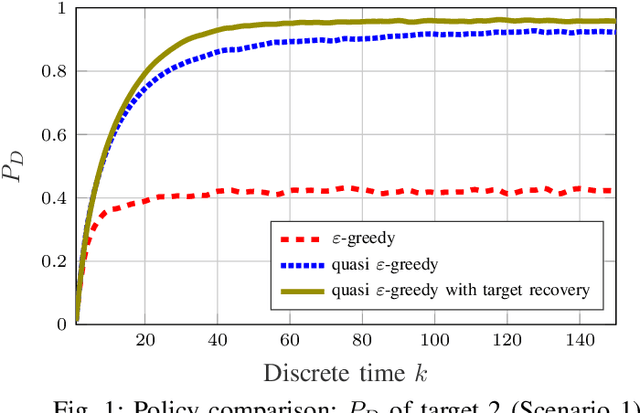
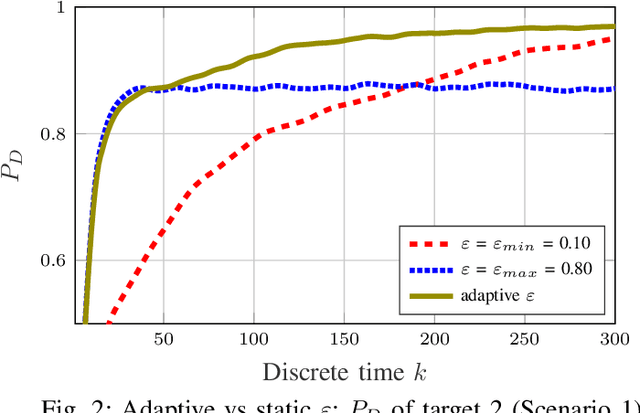
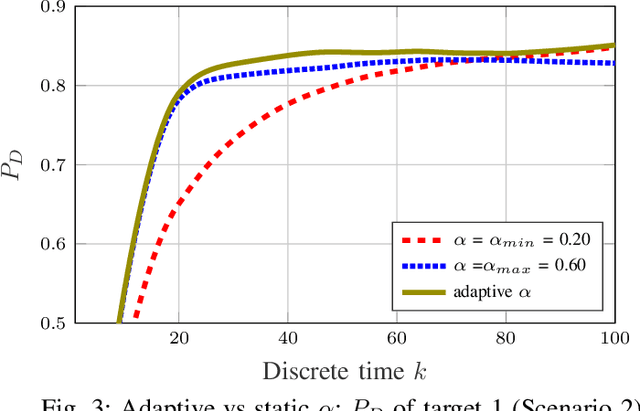
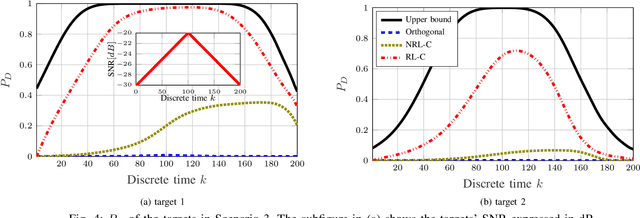
Abstract:In the present work, a reinforcement learning (RL) based adaptive algorithm to optimise the transmit beampattern for a colocated massive MIMO radar is presented. Under the massive MIMO regime, a robust Wald type detector, able to guarantee certain detection performances under a wide range of practical disturbance models, has been recently proposed. Furthermore, an RL/cognitive methodology has been exploited to improve the detection performance by learning and interacting with the surrounding unknown environment. Building upon previous findings, we develop here a fully adaptive and data driven scheme for the selection of the hyper-parameters involved in the RL algorithm. Such an adaptive selection makes the Wald RL based detector independent of any ad hoc, and potentially suboptimal, manual tuning of the hyper-parameters. Simulation results show the effectiveness of the proposed scheme in harsh scenarios with strong clutter and low SNR values.
Adaptive Sparse Array Beamformer Design by Regularized Complementary Antenna Switching
Mar 04, 2021



Abstract:In this work, we propose a novel strategy of adaptive sparse array beamformer design, referred to as regularized complementary antenna switching (RCAS), to swiftly adapt both array configuration and excitation weights in accordance to the dynamic environment for enhancing interference suppression. In order to achieve an implementable design of array reconfiguration, the RCAS is conducted in the framework of regularized antenna switching, whereby the full array aperture is collectively divided into separate groups and only one antenna in each group is switched on to connect with the processing channel. A set of deterministic complementary sparse arrays with good quiescent beampatterns is first designed by RCAS and full array data is collected by switching among them while maintaining resilient interference suppression. Subsequently, adaptive sparse array tailored for the specific environment is calculated and reconfigured based on the information extracted from the full array data. The RCAS is devised as an exclusive cardinality-constrained optimization, which is reformulated by introducing an auxiliary variable combined with a piece-wise linear function to approximate the $l_0$-norm function. A regularization formulation is proposed to solve the problem iteratively and eliminate the requirement of feasible initial search point. A rigorous theoretical analysis is conducted, which proves that the proposed algorithm is essentially an equivalent transformation of the original cardinality-constrained optimization. Simulation results validate the effectiveness of the proposed RCAS strategy.
Reinforcement Learning based Beamforming for Massive MIMO Radar Multi-target Detection
May 10, 2020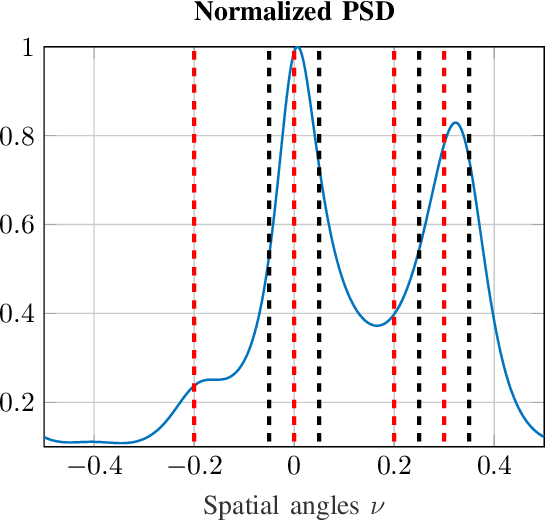
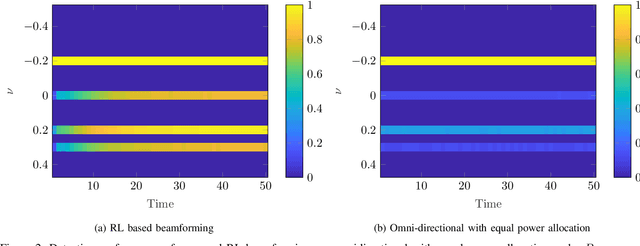
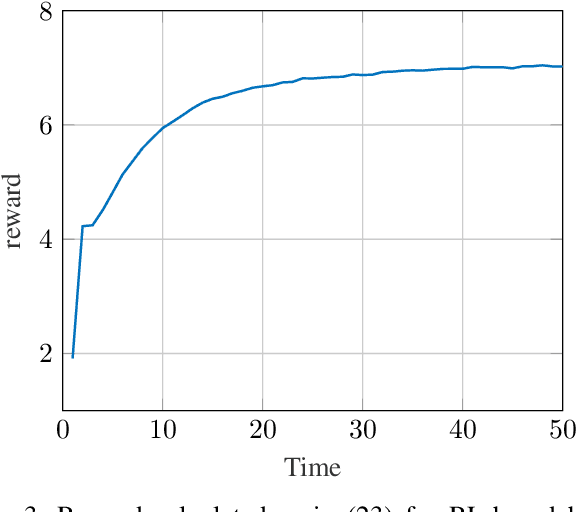
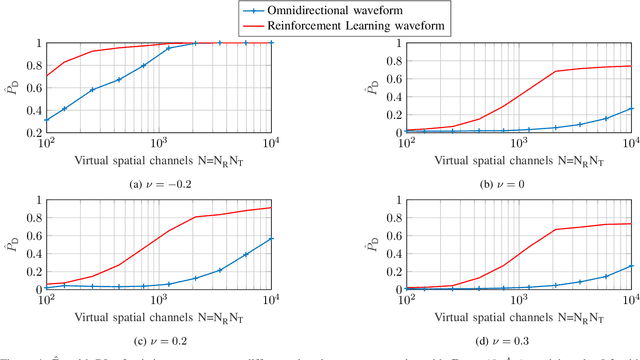
Abstract:This paper considers the problem of multi-target detection for massive multiple input multiple output (MMIMO) cognitive radar (CR). The concept of CR is based on the perception-action cycle that senses and intelligently adapts to the dynamic environment in order to optimally satisfy a specific mission. However, this usually requires a priori knowledge of the environmental model, which is not available in most cases. We propose a reinforcement learning (RL) based algorithm for cognitive beamforming in the presence of unknown disturbance statistics. The radar acts as an agent which continuously senses the unknown environment (i.e., targets and disturbance). Consequently, it optimizes the beamformers through tailoring the beampattern based on the acquired information. Furthermore, we propose a solution to the beamforming optimization problem with less complexity than the existing methods. Numerical simulations are performed to assess the performance of the proposed RL-based algorithm in both stationary and dynamic environments. The RL based beamforming is compared to the conventional omnidirectional approach with equal power allocation. As highlighted by the proposed numerical results, our RL-based beamformer greatly outperforms the omnidirectional one in terms of target detection performance. The performance improvement is even more remarkable under environmentally harsh conditions such as low SNR, heavy-tailed disturbance and rapidly changing scenarios.
 Add to Chrome
Add to Chrome Add to Firefox
Add to Firefox Add to Edge
Add to Edge